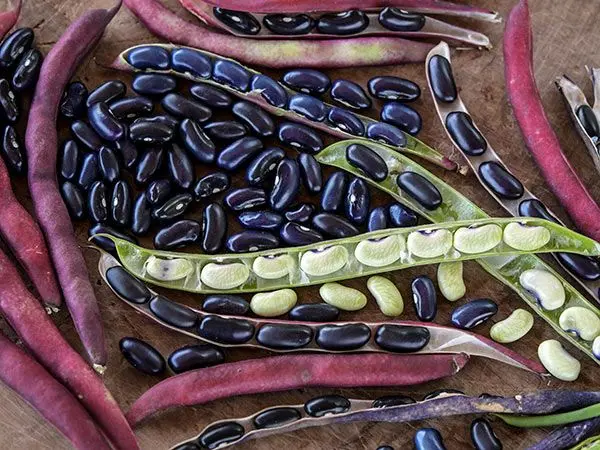There’s always some mystery around what exactly Heirloom seeds are compared to the other seed types like, hybrid, organic, GMO, etc., especially for Beginner Gardeners. I grow open-pollinated and/or Heirloom varieties exclusively in my backyard garden. I’m going to give to you an explanation on the differences of these types and why that matters.
The type of seed, and thus the varieties that are available, have an impact on flavor, nutrition, disease resistance, pest resistance, seed saving, among other factors. This is especially important as you need to be thinking about what you are going to grow in your Spring Garden now!!
Heirloom and Open-Pollinated Seeds
Open-pollinated plant varieties are those that will produce seed that is genetically “true to type”. You can get a mutation if you have multiple varieties of the species in close proximity but most of the time you will get a genetically near-identical version of the plant. Once these seeds have been passed down from generation to generation through standard breeding methods and retain their original traits, the variety can be considered an Heirloom.
Some also consider a seed an Heirloom only if it was passed down amongst families or communities. This would exclude older commercial varieties that are now open-pollinated. I don’t necessarily agree with excluding those types but part of the attraction to Heirloom varieties is the history and stories of communities and people who get credit for preserving and passing down these heirloom seeds.
Examples of Heirloom Seeds
Take for example, the Cherokee Trail of Tears Bean. This black bean heirloom was brought from Tennessee by the Cherokee people as they were marched to Oklahoma by the federal government in 1839. You can imagine being on that forced march bringing with you one of your prized possessions, being beans, from your home. This is a connection to the past and our history!

Another good example is Amish Paste tomatoes. These tomatoes are an old family heirloom tomato from Amish farmers in Medford, Wisconsin. The history of this tomato goes back to the 1870s. Tom Hauch of ‘Heirloom Seeds’ received the seeds of this beautiful and prolific variety from the Amish who lived near Lancaster in Pennsylvania and shared them with ‘Landis Valley Museum’ in Lancaster.

Organic Seeds
Organic seeds are from plants grown by farmers following organic farm management practices, using federal organic standards for growing and processing which excludes the use of synthetic pesticides and genetically engineered/genetically modified or “GMO” technologies.
Hybrid Seeds
Hybrid plant varieties come about from the selective and deliberate cross pollination of two different parent varieties. The goal is to produce offspring with the best traits from each of their parents. Hybrid plants are bred to offer beneficial characteristics to the plants such as disease or pest resistance. You can save the seeds and replant, but nearly all seeds produced by these plants will not be “true to type”. This means that the plant grown from these seeds will not have all the traits from the original parents. If you are not looking to save seeds or don’t really care about the history, hybrid seeds may be a good choice.
GMO Seeds
Genetically modified (GMO) seeds are another type of seeds commercially available. While GMO seeds are often hybrids, most hybrids are not GMO. GMO seeds are made by transferring new DNA into plant cells. Usually, the cells are then grown in tissue culture where they develop into plants. The seeds produced by these plants will inherit the new DNA.
GMO seeds are typically used by large-scale commercial farming with plants like corn, wheat and soybeans. There are no GMO available seeds readily available for most home garden favorites such as tomatoes and peppers. That good, because I really don’t want to plant (or eat) anything that’s had its DNA changed. I guess I’m just old-fashioned that way.
Seed Vendors I use
I routinely order seeds from three or four online stores. All have a great selection of heirloom seeds that I know you will be happy with:
Summary
This article gives you a brief description for all the various types of seeds. As stated earlier, I exclusively use open-pollinated and/or heirloom seeds in my backyard organic raised bed garden
There are several reasons:
- The biggest advantage of Heirloom varieties is the incredible taste. These are 100 x better than varieties you purchase at your local grocery store.
- A real connection to the past. I love history and heirloom seeds inherently come with a history.
- Heirloom varieties give us various traits that you can’t find at the grocery store. Heirloom seeds come in a multitude of different flavors, colors, shapes and sizes. For example, you can grow black tomatoes, yellow carrots, and purple potatoes.
- Heirloom varieties tend to be hardier and have withstood the test of time. There is a reason why heirloom varieties have been passed down generation to generation. It’s because they are outstanding varieties.
- Heirloom produce tend to be more nutritious than those commercially grown. Recognize that produce at the grocery store have been in transit for 1 to 2 weeks before you buy it. With Heirloom produce grown in your own garden, you can pick it at the peak of ripeness and nutrition.
- As mentioned earlier, seed saving is an option as you can get offspring that are “true to type”.
- Finally, with Heirloom seeds, you know they are non-GMO and many can be bought as Organic.
I Choose Heirloom Seeds
There are a multitude of reasons why I use heirloom seeds. I want to provide my reasoning so you could make your own decisions around whether you prefer to use heirloom or other types of seeds. Let’s keep using heirloom seeds and keep their stories alive.
I published this topic in a video back in December so wanted to go ahead and publish it here. If you want to see the video, check out the following:

Leave a Reply